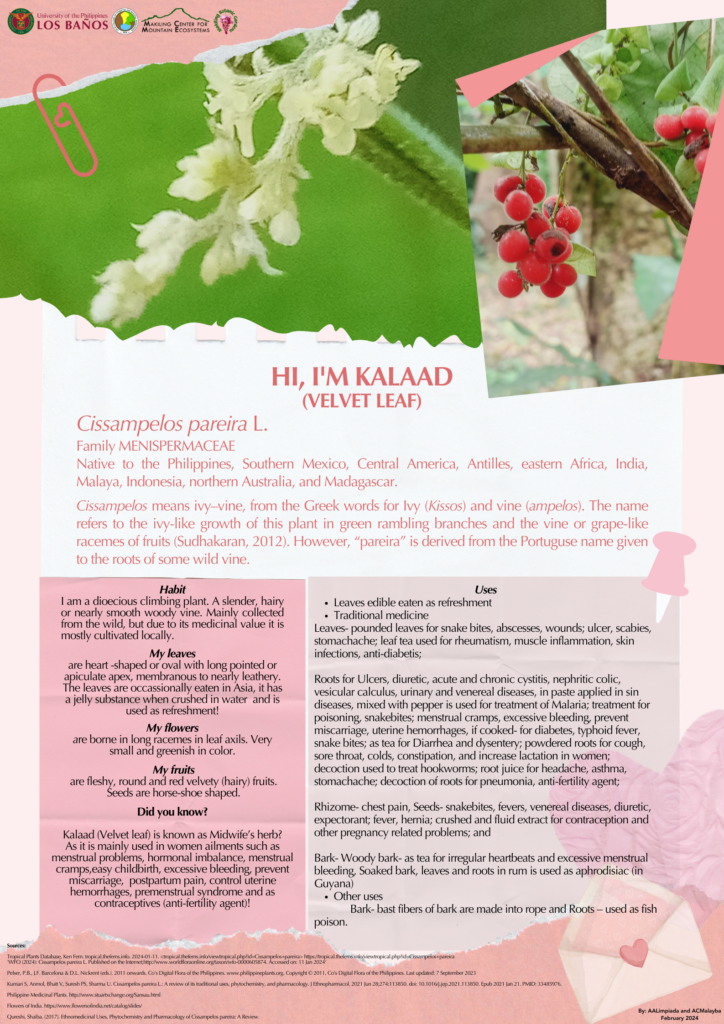
The Makiling Botanic Gardens (MBG) Plant of the Month (POM) for February 2024 is the Kalaad or Velvet Leaf, scientifically known as Cissampelos pareira L. from the family Menispermaceae. The word Cissampelos means ivy–vine, from the Greek words for Ivy (Kissos) and vine (ampelos). The name refers to the ivy-like growth of this plant in green rambling branches and the vine or grape-like racemes of fruits (Sudhakaran, 2012). However, “pareira” is derived from the Portuguse name given to the roots of some wild vine. Kalaad is native to the Philippines, Southern Mexico, Central America, Antilles, eastern Africa, India, Malaya, Indonesia, northern Australia, and Madagascar.
This species is a dioecious climbing plant. It is described as a slender, hairy, or nearly smooth woody vine. It is mainly collected from the wild, but due to its medicinal value, it is mostly cultivated locally. Its leaves are heart-shaped or oval with long pointed or apiculate apex, membranous to nearly leathery. They are occasionally eaten in Asia due to their jelly substance when crushed in water and used as refreshments! Meanwhile, its flowers are borne in long racemes in leaf axils. They are minute and greenish. Its fruits, on the other hand, are fleshy, round, and red velvety (hairy) fruits with seeds that are horse-shoe shaped.
The plant is also a useful traditional medicine. Its leaves are pounded for snake bites, abscesses, wounds; ulcers, scabies, and stomachaches; the leaf tea is used for rheumatism, muscle inflammation, skin infections, and anti-diabetis. Meanwhile, its roots are a traditional treatment for ulcers, diuretics, acute and chronic cystitis, nephritic colic, vesicular calculus, urinary and venereal diseases; used for the treatment of Malaria; treatment for poisoning, snakebites; menstrual cramps, excessive bleeding, prevent miscarriage, uterine hemorrhages, if cooked- for diabetes, typhoid fever, snake bites; as tea for Diarrhea and dysentery; powdered roots for cough, sore throat, colds, constipation, and increase lactation in women; as decoction used to treat hookworms; root juice for headache, asthma, stomachache; and the decoction of roots for pneumonia, anti-fertility agent. Furthermore, its rhizome are used to relieve chest pain and the seeds are used for snakebites, fevers, venereal diseases, diuretics, expectorant; fever, hernia; crushed and fluid extract for contraception and other pregnancy-related problems. Finally, its bark is made into tea for irregular heartbeats and excessive menstrual bleeding and used as an aphrodisiac (in Guyana). For non-medicinal use, its bark bast fibers are made into rope and its roots are used as fish poison.
Did you know?
Kalaad (Velvet leaf) is known as Midwife’s herb? Because it is mainly used for women’s ailments such as menstrual problems, hormonal imbalance, menstrual cramps, easy childbirth, excessive bleeding, prevent miscarriage, postpartum pain, control uterine hemorrhages, premenstrual syndrome, and as a contraceptive or anti-fertility agent!
View its dedicated video via this link: https://youtu.be/7UsoFr05Zzs
By: AALimpiada and ACMalayba


